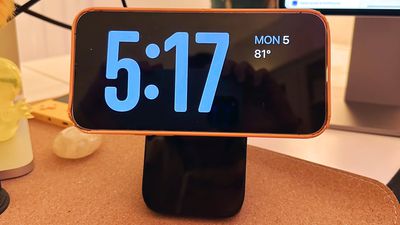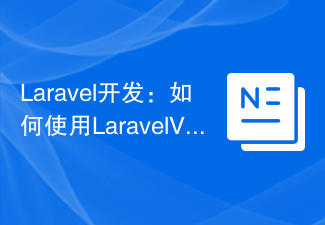 PHP Framework
PHP Framework Laravel
Laravel Views and template engines in Laravel: building beautiful and customizable interfaces
Views and template engines in Laravel: building beautiful and customizable interfaces
View and Template Engine in Laravel: Building Beautiful and Customizable Interfaces
Overview:
When developing web applications, the design and layout of the interface are usually is crucial. Laravel, as a popular PHP framework, provides a powerful view system and template engine, allowing developers to easily build beautiful and customizable interfaces. This article will introduce the views and template engine in Laravel and provide some sample code to help readers better understand and apply these concepts.
View:
In Laravel, the view is the part used to render the user interface. They are stored in the resources/views directory and can be referenced by simple file names. Views typically contain HTML markup and PHP code for displaying dynamic content and application logic.
Example 1: Create a simple view
First, we create a file named hello.blade.php and save it in the resources/views directory. The content of the file looks like this:
<html>
<head>
<title>Hello World</title>
</head>
<body>
<h1 id="Hello-name">Hello, {{$name}}!</h1>
</body>
</html> In the above example, we used Laravel’s template engine syntax. We can insert dynamic content into the view by surrounding variables with two curly braces ({{ }}). In this example, we display a name using {{$name}}.
Here is the sample code of how to render the view in the route:
Route::get('/', function () {
return view('hello', ['name' => 'John']);
});In the above code, we use the view function to render the hello view and pass the variables in the form of associative array. Variables are automatically parsed and replaced by the view engine.
Template engine:
The template engine in Laravel is based on the Blade template engine. It provides a simple yet powerful set of tools that make it easier for you to build and manage templates. By using a template engine, you can design reusable interface components, include conditional branches and looping structures, and run simple expressions.
Example 2: Build a table using a template engine
Create a file named table.blade.php in the resources/views directory and set its content to the following code:
<table>
<thead>
<tr>
<th>Name</th>
<th>Email</th>
</tr>
</thead>
<tbody>
@foreach($users as $user)
<tr>
<td>{{$user->name}}</td>
<td>{{$user->email}}</td>
</tr>
@endforeach
</tbody>
</table>In the above example, we use the @foreach directive of the Blade template engine to iterate through the user array and display the name and email in each row of the table.
Here is the sample code of how to render the table view in the controller:
public function showTable()
{
$users = User::all();
return view('table', ['users' => $users]);
}In the above code, we get the array of all users from the database and pass it to the table view.
Conclusion:
Laravel’s view system and template engine provide developers with powerful tools to build beautiful and customizable interfaces. By using views and template engines, we can easily separate interface logic and application logic and provide reusable interface components. In this article, we introduce the basic concepts of views and template engines in Laravel and provide some sample code to help readers better understand and apply these concepts. I hope this article can help you learn and use Laravel views and template engines.
The above is the detailed content of Views and template engines in Laravel: building beautiful and customizable interfaces. For more information, please follow other related articles on the PHP Chinese website!
 iOS 17 的待机模式将正在充电的 iPhone 变成家庭集线器Jun 06, 2023 am 08:20 AM
iOS 17 的待机模式将正在充电的 iPhone 变成家庭集线器Jun 06, 2023 am 08:20 AMiOS17中的Apple正在引入待机模式,这是一种新的显示体验,专为水平方向的充电iPhone而设计。处于这个位置的iPhone能够显示一系列全屏小部件,将其变成一个有用的家庭中心。待机模式会在水平放置在充电器上运行iOS17的iPhone上自动激活。您可以查看时间、天气、日历、音乐控制、照片等信息。您可以通过可用的待机选项向左或向右滑动,然后长按或向上/向下滑动以进行自定义。例如,随着时间的流逝,您可以从模拟视图、数字视图、气泡字体和日光视图中进行选择,其中背景颜色会根据时间而变化。有一些选项
 Laravel开发:如何使用Laravel View生成视图?Jun 14, 2023 pm 03:28 PM
Laravel开发:如何使用Laravel View生成视图?Jun 14, 2023 pm 03:28 PMLaravel是目前最流行的PHP框架之一,其强大的视图生成能力是让人印象深刻的一点。视图是Web应用程序中展示给用户的页面或视觉元素,其中包含HTML、CSS和JavaScript等代码。LaravelView允许开发者使用结构化的模板语言来构建网页,同时通过控制器和路由生成相应的视图。在本文中,我们将探讨如何使用LaravelView生成视图。一、什
 php如何使用CodeIgniter4框架?May 31, 2023 pm 02:51 PM
php如何使用CodeIgniter4框架?May 31, 2023 pm 02:51 PMPHP是一种非常流行的编程语言,而CodeIgniter4是一种常用的PHP框架。在开发Web应用程序时,使用框架是非常有帮助的,它可以加速开发过程、提高代码质量、降低维护成本。本文将介绍如何使用CodeIgniter4框架。安装CodeIgniter4框架CodeIgniter4框架可以从官方网站(https://codeigniter.com/)下载。下
 PHP编程中有哪些常见的模板引擎?Jun 12, 2023 am 09:50 AM
PHP编程中有哪些常见的模板引擎?Jun 12, 2023 am 09:50 AM最近几年,PHP编程中的模板引擎已经成为了PHP开发的重要组成部分,方便了程序员进行页面开发和管理。本文将介绍PHP编程中常见的模板引擎。SmartySmarty是一个比较常用的PHP模板引擎,它支持缓存模板、插件模块和自定义函数等一系列功能。Smarty的语法十分灵活,能够解决PHP变量与HTML标记的结合难题,使得PHP语言更适用于模板化的设计。而且,S
 学习使用Golang模板引擎:在Golang中使用模板的基础指南Jan 20, 2024 am 10:13 AM
学习使用Golang模板引擎:在Golang中使用模板的基础指南Jan 20, 2024 am 10:13 AMGolang模板引擎入门指南:如何在Golang中使用模板,需要具体代码示例简介:模板引擎是一种能将数据和模板进行组合并生成HTML、文本或其他格式文档的工具。在Golang中,我们可以使用内置的模板包(html/template)来实现模板引擎的功能。本文将详细介绍如何在Golang中使用模板引擎,并提供具体的代码示例。一、模板引擎的基本概念在了解如何使用
 Django框架中的视图详解Jun 17, 2023 am 10:18 AM
Django框架中的视图详解Jun 17, 2023 am 10:18 AMDjango是一个高度可定制的Web框架,它提供了许多方便的工具和库,来帮助开发者快速创建高性能的、可扩展的Web应用程序。其中,视图是Django框架中最重要的组成部分之一。视图负责处理来自客户端的请求,并返回相应的响应。在本文中,我们将深入探讨Django框架中的视图,并介绍如何使用它来创建高性能、可定制的Web应用程序。一、视图的基本概念在Django
 ThinkPHP6模板引擎使用指南:打造精美的前端界面Aug 26, 2023 pm 11:09 PM
ThinkPHP6模板引擎使用指南:打造精美的前端界面Aug 26, 2023 pm 11:09 PMThinkPHP6模板引擎使用指南:打造精美的前端界面引言:随着Web应用程序的发展,前端界面的设计和开发变得愈发重要。作为一个开发人员,我们需要使用一个强大的模板引擎来帮助我们创建和管理前端界面。ThinkPHP6的模板引擎正是满足这一需求的强大工具。本文将介绍如何使用ThinkPHP6模板引擎来打造精美的前端界面。第一部分:安装ThinkPHP6模板引擎
 如何在Fat-Free框架中使用模板引擎Blade?Jun 03, 2023 pm 08:40 PM
如何在Fat-Free框架中使用模板引擎Blade?Jun 03, 2023 pm 08:40 PMFat-Free框架是一个轻量级的PHP框架,旨在提供简单而灵活的工具来构建Web应用程序。它包含许多有用的功能,例如路由、数据库访问、缓存等。在Fat-Free框架中,使用Blade模板引擎可以帮助我们更方便地管理和渲染模板。Blade是Laravel框架中的模板引擎,它提供了强大的语法和模板继承功能。在本文中,我将演示如何在Fat-Free框架中使用Bl


Hot AI Tools

Undresser.AI Undress
AI-powered app for creating realistic nude photos

AI Clothes Remover
Online AI tool for removing clothes from photos.

Undress AI Tool
Undress images for free

Clothoff.io
AI clothes remover

AI Hentai Generator
Generate AI Hentai for free.

Hot Article

Hot Tools

EditPlus Chinese cracked version
Small size, syntax highlighting, does not support code prompt function

SublimeText3 Linux new version
SublimeText3 Linux latest version

ZendStudio 13.5.1 Mac
Powerful PHP integrated development environment

Notepad++7.3.1
Easy-to-use and free code editor

SublimeText3 English version
Recommended: Win version, supports code prompts!






